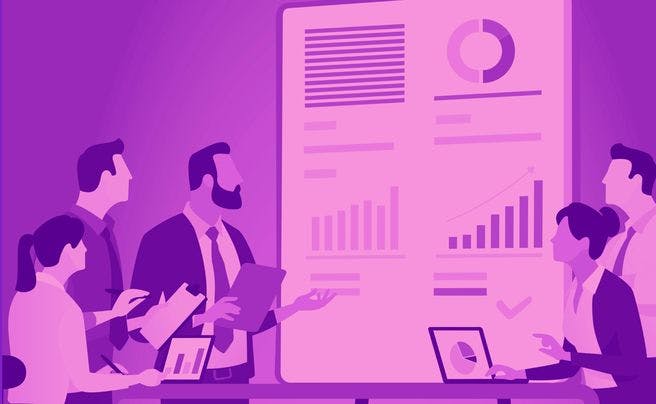As major proponents of leveraging AI to optimize performance (our own contract intelligence platform is AI-powered), we are constantly watching for the latest and greatest developments in the intelligence space. If the past few years have taught us anything, it’s that staying abreast of changes and being early adopters can make or break a business. And we find the intelligence arena to be particularly important in that conversation.
Here are some of the top trends in AI to keep an eye on in 2023.
Trend Alert: Low or No-Code AI
As the name implies, no-code AI removes the colossal task of sourcing and employing AI engineers, and offers organizations an AI-powered solution that is basically turnkey.
Some popular examples of this technology are:
Apple CreateML: Simple API for training machine learning models
DataRobot: Cloud-based platform that can help automate data prep and creating/deploying algorithms
Microsoft Lobe: Trains image recognition algorithms
Akkio: Service that creates AI-powered workflows from data tables and predicts business outcomes
PyCaret: Open-source, low-code library in Python (the programming language) that automates machine learning workflows
A low-code or no-code AI solution allows you to implement smart software into your organization without having to build it, or even do much tweaking. Easy integration, speed-to-value, and being far more cost effective than custom AI are just a few of the benefits of this type of solution.
But that doesn’t necessarily mean it’s an AI silver bullet for businesses. “Choosing to adopt no-code AI in your business isn’t a matter to be taken lightly,” this Forbes article explains. “Like all business decisions, it’s essential to analyze specifically how the intended solution should fit within your overall ecosystem beforehand. Fail to do so and you could be left with a pretty pricey piece of tech that doesn’t work as you intended. In some cases, your business may better benefit from a fully custom AI solution rather than a no-code variant. However, this will only be uncovered via a deeper analysis of your business’s specific needs.”
Trend Alert: Staff Augmentation
Another hot topic of 2023 is the augmented workforce. Where this traditionally means outsourcing human workers, we’re now seeing AI come into the picture and offer a new facet to the world of staff augmentation. This doesn’t necessarily mean that technology will replace human jobs; rather, we are seeing a shift to working as a team alongside AI.
This Toptal article explains: “Staff augmentation is a powerful model that organizations can leverage to increase agility and respond to the changing needs of the enterprise. It’s being used increasingly across industry borders. [...] When considered in light of moves from industry giants like Google — which acquired a freelance/contract network of data scientists called Kaggle in 2017 — the importance of augmented staff for enterprises, now and in the future, cannot be overstated.”
Smarter tools and services are constantly emerging, and it’s significantly changing the work landscape. From AI-driven marketing software to data aggregation, there are SaaS solutions that can mitigate the workload of their users with intelligence — and in some cases, with a built-in services offering.
In fact, we recently released an eBook about this very subject, titled Optimization Unlocked: Elevating Your Contract Management Strategy with Services. You can learn more about this subject and download your free copy here.
Trend Alert: Cybersecurity
Advances in AI can benefit both organizations and cyber attackers. The current state of the economy means that IT teams might be understaffed or underfunded, and the rise of inflation means that businesses will have to be strategic about which tech solutions they preserve budget for. But cyber criminals know this. They bet on organizations having weakened defenses during a looming recession — and we can expect to see an increase in attempted attacks as a direct result.
“Experts predict AI will impact the ‘arms race’ between cyberattackers and defenders, while economic issues and a skills shortage will impact the industry,” writes Leigh McGowran for SiliconRepublic.
McGrowan goes on to list some cybersecurity predictions for the year, including the role that remote work plays in the overall picture.
“VMware’s global security technologist Chad Skipper warns companies that they are only as secure as the ‘weakest link’ in the supply chain,” McGrowan writes. “He said criminals will continue to utilize ‘island hopping’ in 2023, which is when a threat actor hijacks an organization’s infrastructure to attack its customers.”
Notably, those in the healthcare industry should be aware of this threat, as people’s personal medical data is at risk.
So, what can organizations do to protect themselves? Certain AI technologies such as machine learning and natural language processing can offer near-immediate insights, cutting down on response times to cyber attacks.
“AI can help us provide accuracy in detection,” says Sridhar Muppidi, Chief Technology Officer of IBM Security. “AI can help in accelerating the investigation and automating the response. We use AI to do a continuous verification of the user based on behavioral biometrics. This helps us evaluate the risk of a specific user for a specific session. Based on that, we are able to subject the user to the right amount of friction. If the risk is low, we don’t need to subject the user to multiple passwords. On the other hand, if the risk is high, we may want to prompt the user for a password, or even a second-factor authentication.”
Trend Alert: Creative/Generative AI
This is a trend you’ve likely heard discussed at length over the past several months. From ChatGPT to AI-generated artwork, the creative world has experienced a major shakeup from this emerging technology. And whether you like it or not, it’s seemingly only going to become more pervasive.
From social media posts to music to video games, creative AI can produce just about anything you can think of.
According to Balakrishna DR, EVP and head of AI and automation at Infosys, “Using generative AI, Enterprises can create a variety of content like images, videos, and written material and decrease turnaround time. Generative AI networks employ transfer-style learning or general adversarial networks to create immersive content from different sources.”
While there has been tension around the subject (i.e. educators finding an increase in plagiarized essays, as well as an emergence of “deepfakes”), business leaders stand to gain a lot from utilizing generative AI in their marketing endeavors. Writing a headline or designing a logo can now be done in the blink of an eye, meaning creativity can be generated on demand. That’s not to say this technology is better (or even as good as) the creative work of humans, but it can certainly be useful if your team is at capacity or you’re looking to try more A/B testing. Consider generative AI as a new addition to your creative team’s tool box, rather than an alternative to their natural talents.
Final Thoughts
Google CEO Sundar Pichai has said that AI “is one of the most profound technologies we are working on, as important or more than fire and electricity.” A pretty weighty statement, but is it actually proving to be true? Pichai went on to say, “For humankind, it's always been about balancing the positives and the negatives and harnessing it to make sure it benefits society. This is going to be no different. The stakes are higher.”
Like it or not, AI is here to stay. But why resist this technology when it can do so much for your organization? It’s all about finding the right solution(s) for your business needs.
From finance to marketing, nearly every sector is seeing the ways in which AI can optimize workflows, forecast spend insights, aid in A/B testing, and more. Conducting efficiency audits throughout your company and determining which areas would benefit most from AI is a great place to start. Which groups spend the most time doing manual processes? What’s the margin of error in data reporting? Is your creative team at capacity and unable to take on important work? Finding out how much time, money, and resources are wasted across verticals will be an indicator of how much your organization could be doing with the right tools in place.
Because truth be told, it’s not a matter of if you should be adopting this technology — it’s when. And if you ask us (or most of the leaders in tech), the answer is now.




